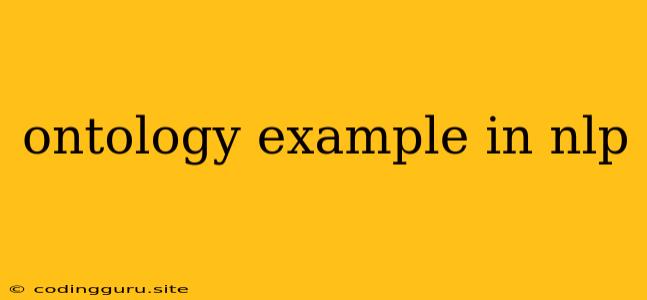Ontology Example in NLP: Understanding the World
Natural Language Processing (NLP) is about giving computers the ability to understand and process human language. But how do we teach machines the nuances of human language? One powerful tool in NLP is ontology.
An ontology is a formal representation of knowledge about a specific domain. It defines the concepts, entities, and relationships within that domain, providing a structured framework for understanding and reasoning about information. Imagine it as a knowledge base for machines, providing them with the context needed to interpret human language.
Why Ontologies are Important for NLP
- Knowledge Representation: Ontologies provide a structured way to represent knowledge, making it easier for machines to understand and process information.
- Semantic Understanding: By defining relationships between concepts, ontologies enable machines to understand the meaning of words and phrases, not just their literal meaning.
- Information Retrieval and Reasoning: Ontologies help machines retrieve relevant information and draw logical inferences based on the relationships between concepts.
- Cross-Domain Communication: Ontologies facilitate communication and data exchange between different systems and applications.
A Simple Ontology Example
Let's consider a simple example of an ontology for the domain of "fruits". We can define concepts like "apple", "banana", "orange", and "fruit". We can also define relationships between these concepts:
- "is_a" relationship: "Apple is_a Fruit", "Banana is_a Fruit", "Orange is_a Fruit".
- "has_color" relationship: "Apple has_color Red", "Banana has_color Yellow", "Orange has_color Orange".
With this ontology, a machine can understand that an apple is a type of fruit and that it has a red color. It can also infer that an orange is also a type of fruit because it has a relationship with the "Fruit" concept.
Real-World Applications of Ontologies in NLP
- Search Engines: Ontologies help search engines understand the meaning of search queries and return relevant results. For example, if you search for "red fruit", an ontology can help the search engine identify fruits that have the property of being red.
- Chatbots: Ontologies are essential for chatbots to understand the intent and context of user queries. They enable chatbots to respond appropriately to user input, providing relevant information or completing tasks.
- Information Extraction: Ontologies help machines extract key information from text documents. For instance, they can identify the names of people, locations, or events mentioned in a text and their relationships to each other.
- Machine Translation: Ontologies can be used to represent the semantic relationships between words in different languages, improving the accuracy of machine translation systems.
Building an Ontology
Creating an ontology involves a few steps:
- Domain Identification: Define the specific area of knowledge you want to model.
- Concept Identification: Identify the key concepts and entities within the domain.
- Relationship Definition: Define the relationships between the concepts, such as "is_a", "has_a", or "part_of".
- Instance Definition: Identify specific instances of each concept, such as individual fruits or types of fruit.
Conclusion
Ontology is a powerful tool for NLP, providing a structured framework for representing knowledge and enabling machines to understand the meaning and relationships within a given domain. By understanding the concept of ontology, we can create more sophisticated NLP applications that can process and understand human language more effectively.
